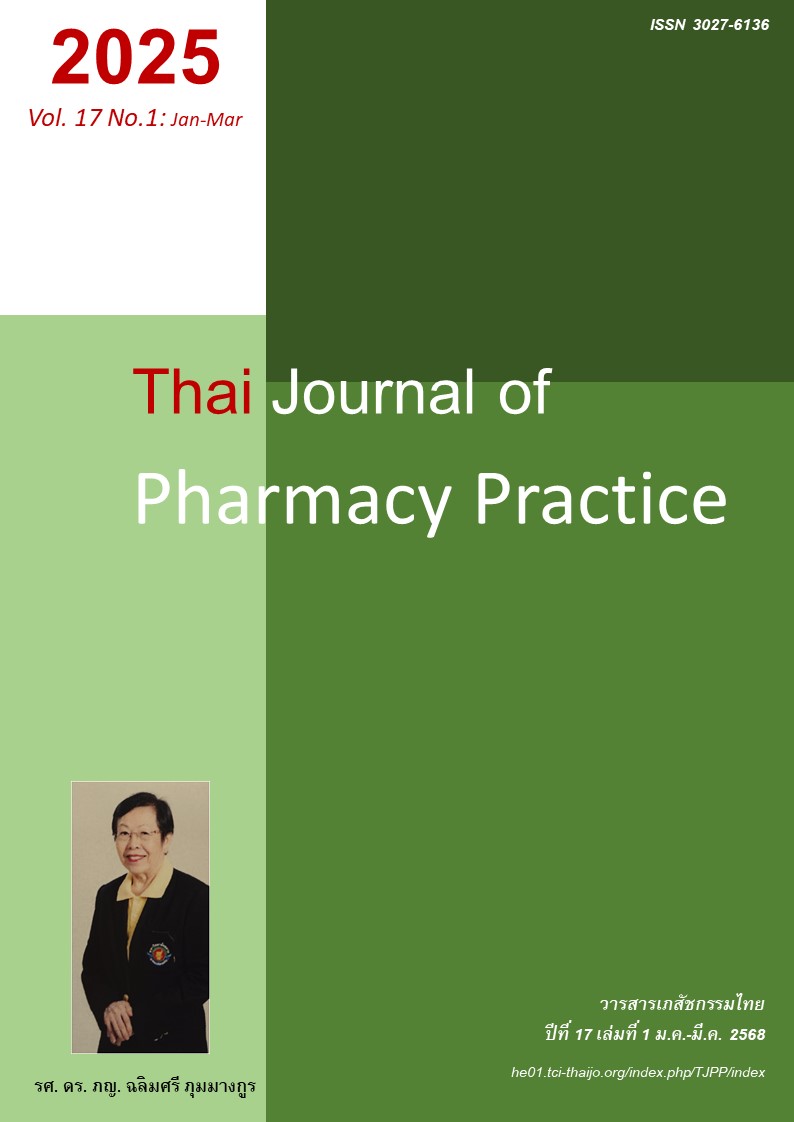ผลของการให้บริการตามรูปแบบการบริบาลทางเภสัชกรรมร่วมกับสหวิชาชีพใน คลินิกกัญชาทางการแพทย์แผนไทย ณ โรงพยาบาลห้วยเกิ้ง จังหวัดอุดรธานี
Main Article Content
บทคัดย่อ
วัตถุประสงค์: เพื่อวัดผลลัพธ์ของการให้บริการตามรูปแบบการบริบาลทางเภสัชกรรมร่วมกับสหวิชาชีพ (multidiscipli- nary pharmaceutical care model: MPCM) ณ คลินิกกัญชาทางการแพทย์แผนไทย โรงพยาบาลห้วยเกิ้ง จังหวัดอุดรธานี (คลินิกกัญชาฯ) วิธีการ: การศึกษานี้เป็นการวิจัยเชิงปฏิบัติการที่ต่อเนื่องจากระยะวางแผน การศึกษาประกอบด้วย 3 ระยะ คือ 1. ระยะปฏิบัติการ โดยเก็บข้อมูลเกี่ยวกับปัญหาจากการใช้ยา (drug related problems: DRPs) ในผู้ป่วยนอกที่เข้ารับบริการในคลินิกกัญชาฯ อย่างต่อเนื่องจำนวน 120 คน โดยเป็นผู้ป่วยในกลุ่มที่มีอาการปวดกล้ามเนื้อและกระดูกเรื้อรัง โรคไมเกรน โรคนอนไม่หลับ และโรคมะเร็ง ร้อยละ 30.8, 26.6, 17.5 และ 7.5 ตามลำดับ ต่อมาทดลองให้บริการตาม MPCM ที่ออกแบบจากระยะวางแผนในผู้ป่วย 3 เดือน 2. ระยะสังเกตการณ์เป็นการประเมินผลลัพธ์หลังการใช้ MPCM จากจำนวน DRPs เฉลี่ยที่เปลี่ยนแปลง และ 3. ระยะสะท้อนผลเป็นการใช้วิธีการสนทนากลุ่มในทีมสหวิชาชีพเพื่อสอบถามความเห็นต่อ MPCM ผลการศึกษา: จำนวน DRPs ทั้งหมดก่อนการนำ MPCM มาใช้เท่ากับ 81 ครั้ง หรือเฉลี่ย 0.68 ปัญหาต่อราย หลังการนำ MPCM มาใช้พบ DRPs ลดลงอย่างมีนัยสำคัญทางสถิติเหลือ 10 ครั้งหรือเฉลี่ย 0.08 ปัญหาต่อราย (P=0.045) ทั้งก่อนและหลังการนำ MPCM มาใช้พบว่า DRPs ประเภทที่ส่งผลต่อความปลอดภัยมากกว่าประเภทที่ส่งผลต่อการรักษา สาเหตุของ DRPs ที่พบมากที่สุด คือ พฤติกรรมการใช้ยาของผู้ป่วยไม่เหมาะสม ซึ่งพบว่ามีจำนวนลดลงจาก 44 ครั้งเหลือ 4 ครั้ง (ลดลงร้อยละ 90.9) หลังจากนำ MPCM มาใช้ ทั้งนี้ในช่วงก่อนนำ MPCM มาใช้ เภสัชกรแก้ไข DRPs ด้วยความพยายาม 81 ครั้ง โดยเป็นผู้ประสานงานระหว่างแพทย์ พยาบาล เภสัชกรท่านอื่น ๆ ทั้งในและนอกโรงพยาบาล รวมถึงผู้ป่วยและญาติผู้ป่วย มีการยอมรับการแก้ไขปัญหาจำนวน 77 ปัญหา (ร้อยละ 95.0) ผู้ป่วย 105 ราย (ร้อยละ 87.5) มีผลการรักษาที่ดีขึ้นภายหลังจากการนำ MPCM มาใช้ ส่วนในขั้นตอนสะท้อนผล ทีมสหวิชาชีพเห็นตรงกันว่า MPCM ที่ร่วมกันออกแบบเป็นประโยชน์ต่อผู้ป่วย และทำให้ระบบงานมีคุณภาพมากขึ้นและเห็นควรใช้ต่อไป สรุป: ขั้นตอนการบริการตาม MPCM ในคลินิกกัญชาฯ ลด DRPs ทั้งระดับผู้ป่วยและระดับผู้สั่งใช้ยา โดยเภสัชกรมีบทบาทสำคัญในการค้นหา ป้องกัน และแก้ไข DRPs ร่วมกับทีมสหวิชาชีพและผู้ป่วย ส่งผลให้ผลการรักษาดีขึ้นและผู้ป่วยมีความปลอดภัยจากการใช้ยามากขึ้น จึงควรนำ MPCM ไปปรับใช้ในคลินิกกัญชาฯ ต่อไป
Article Details

อนุญาตภายใต้เงื่อนไข Creative Commons Attribution-NonCommercial-NoDerivatives 4.0 International License.
ผลการวิจัยและความคิดเห็นที่ปรากฏในบทความถือเป็นความคิดเห็นและอยู่ในความรับผิดชอบของผู้นิพนธ์ มิใช่ความเห็นหรือความรับผิดชอบของกองบรรณาธิการ หรือคณะเภสัชศาสตร์ มหาวิทยาลัยสงขลานครินทร์ ทั้งนี้ไม่รวมความผิดพลาดอันเกิดจากการพิมพ์ บทความที่ได้รับการเผยแพร่โดยวารสารเภสัชกรรมไทยถือเป็นสิทธิ์ของวารสารฯ
เอกสารอ้างอิง
Department of Thai Traditional and Alternative Medicine, Ministry of Public Health. Standards for providing services for Thai traditional medical cannabis clinics in hospitals [online]. 2019 [cited Jul 22, 2022]. Available from: thaicam.go.th/category/ma rijuana/
Department of Medical Services, Ministry of Public Health. Guidelines for organizing integrated medical cannabis clinic services. Nonthaburi: Office of Printing Works Veterans Relief Organization; 2021.
Hepler CD, Strand LM. Opportunities and responsibi lities in pharmaceutical care. Am J Hosp Pharm 1990 ; 47: 533-43.
Allemann SS, van Mil JW, Botermann L, Berger K, Griese N, Hersberger KE. Pharmaceutical care: the PCNE definition 2013. Int J Clin Pharm 2014; 36: 544-55. doi: 10.1007/s11096-014-9933-x.
Prosk E, Arboleda MF, Rapin L, Hage CE, Dworkind M. The model of care at a leading medical cannabis clinic in Canada. Complement Ther Med 2021; 60: 102740. doi: 10.1016/j.ctim.2021.102740.
Ruiz-Ramos J, Hernández MH, Juanes-Borrego AM, Milà R, Mangues-Bafalluy MA, Mestres C. The impact of pharmaceutical care in multidisciplinary teams on health outcomes: Systematic review and meta-analysis. J Am Med Dir Assoc 2021; 22: 2518-26. doi: 10.1016/j.jamda.2021.05.038.
Chaisaeng S. Development of a counseling clinic model for medical cannabis extract use at Ban Non Du Tambon Health Promoting Hospital, Mueang District, Amnat Charoen Province. Regional Health Promotion Center 9 Journal 2022; 16: 45-58.
Kaewchana S, Anusornsangiam W. Development of care model for patients with chronic kidney disease by multidisciplinary providers at Nang Rong Hospital. Thai Journal of Pharmacy Practice 2020; 12: 195-206.
Seechiangsa K, Kanjanasilp J, Suttiruksa S. Develop ment of the system for caring schizophrenic patients in community by multidisciplinary team of health network of Amphoe Ban Thaen, Chaiyaphum Province. Thai Journal of Pharmacy Practice 2019; 11: 457-69.
Changpetch P., Miteemitr P. Development of partici- pation of pharmacist for cancer patients in Jaokunpi- boonphanomtuan hospital. Veridian E-Journal Science and Technology Silpakorn University 2015; 2: 50-75.
Chatakarn V. Action research. Suratthani Rajabhat Journal 2015; 2: 29-49
Kuttiya S, Kessomboon N. Development of a multi- disciplinary pharmaceutical care model in Thai traditional medical cannabis clinics at HuaiKoeng hospital, Udonthani Province. Thai Journal of Pharmacy Practice In press. 2024; 16: 1080-97.
Pharmaceutical Care Network Europe Foundation. PCNE classification for drug related problems V 9.1 [online]. 2020 [cited Feb 27, 2022]. Available from: www.pcne.org/upload/files/417_PCNE_classifi cation_V9-1_final.pdf
Hartwig SC, Denger SD, Schneider PJ. Severity indexed, incident report-based medication error reporting program. Am J Hosp Pharm 1991; 48: 2611-6.
Kulprom W. Inpatient pharmaceutical care at Chattu- rus community hospital [master thesis]. Bangkok: Chulalongkorn University; 1999.
Chanatepaporn P. Assessments of pharmaceutical care in female-medical ward in university hospital. Srinagarind Medical Journal 2006; 21: 282–8.
ManeephanP, Rookkapan K. Drug related problems in patients hospitalized to a community hospital within three border southern provinces and manage- ment of the problems by pharmacist. Thai Journal of Pharmacy Practice 2018; 10: 552-62.
Isaac S, Saini B, Chaar BB. The role of medicinal cannabis in clinical therapy: pharmacists' perspec- tives. PLoS ONE 2016; 11:e0155113. doi: 10.1371/journal.pone.0155113.
Hwang J, Arneson T, St Peter W. Minnesota pharmacists and medical cannabis: A survey of knowledge, concerns, and interest prior to program launch. P & T 2016; 41: 716–22.
Colbert J, McBane S, Anouty Y, Cheng T, Xinyu J, Dong J, et al. The pharmacist’s role in medical marijuana counseling: Patient and pharmacist perspective. J Contem Pharm Pract 2018; 65: 24-9.
Nichols MA, Arnett SJ, Fa B, Marchionda RA, Cutting MC, McDonald MR, et al. National survey identifying community pharmacist preceptors' expe- rience, knowledge, attitudes, and behaviors influencing intent to recommend cannabidiol products. J Am Pharm Assoc 2021; 61: S91-104. doi: 10.1016/j.japh.2021.01.016.
Patel S, Doroudgar S, Ip EJ. Community pharma- cists’ lack of knowledge and confidence in non-prescription cannabidiol products. Res Soc Admin Pharm 2021; 17: 1356–60.
Sooksa-Art J, Thipraksa T, Hanrinth R , Kerdchan tuk P, Suttiruksa S. Outcomes of pharmaceutical care in outpatients with Alzheimer’s disease: A pilot study. Thai Journal of Pharmacy Practice 2018; 10: 129-41.
Kitdumrongthum S, Trachootham D. An individuality of response to cannabinoids: challenges in safety and efficacy of cannabis products. Molecules 2023; 28: 2791. doi.org/10.3390/molecules28062791
Jaroenpan T, Sitthiworanan C. Development of the pharmacist’s role as part of a multidisciplinary team providing home pain management treatment to advanced stage cancer patient Nongsua Hospital, Pathumthan. Thai Bulletin Pharmaceutical Sciences 2022; 17: 1-21


